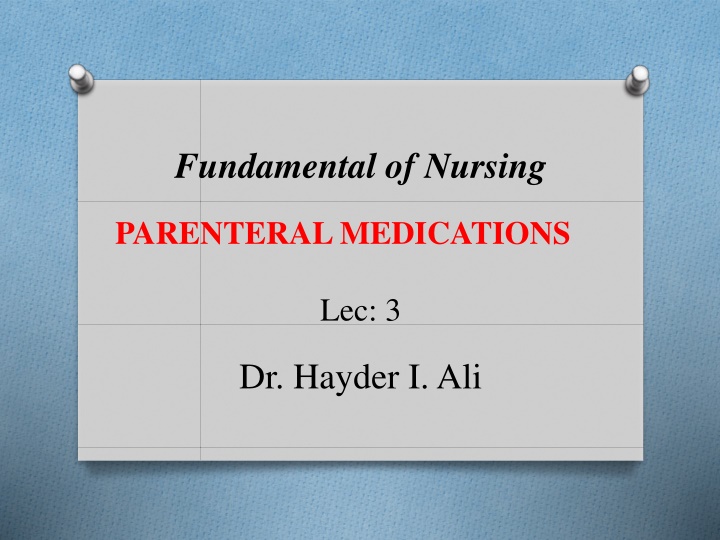
Nursing Procedures for Parenteral Medication Administration
Learn about the common nursing procedures for parenteral medication administration, including intradermal, subcutaneous, and intramuscular injections. Understand the proper techniques and considerations for each type of injection. Proper administration is crucial for patient safety and effective treatment.
Download Presentation

Please find below an Image/Link to download the presentation.
The content on the website is provided AS IS for your information and personal use only. It may not be sold, licensed, or shared on other websites without obtaining consent from the author. If you encounter any issues during the download, it is possible that the publisher has removed the file from their server.
You are allowed to download the files provided on this website for personal or commercial use, subject to the condition that they are used lawfully. All files are the property of their respective owners.
The content on the website is provided AS IS for your information and personal use only. It may not be sold, licensed, or shared on other websites without obtaining consent from the author.
E N D
Presentation Transcript
Fundamental of Nursing PARENTERAL MEDICATIONS Lec: 3 Dr. Hayder I. Ali
Parenteral administration of medications (injection): is a common nursing procedure. Nurses give parenteral medications as: 1- Intra-dermally (ID). 2- Subcutaneously (SC). 3- Intramuscularly (IM). 4- Intravenously (IV)
1. Intradermal Injections An intradermal (ID) injection is the administration of a drug into the dermal layer of the skin. Figure (2)Intradermal Injections
- Usually only a small amount of liquid is used, for example, 0.1 mL. - Used for allergy testing and tuberculosis (TB) screening. Figure (3) Body sites commonly used for intradermal injections
2. Subcutaneous Injections: - Many kinds of drugs administered subcutaneously (just beneath the skin) are: vaccines, insulin, and heparin. - These areas are convenient and normally have good blood circulation.
Figure (4) Common sites for subcutaneous injections
3. Intramuscular Injections Intramuscular (IM) injections: injections into muscle tissue. - Which are absorbed more quickly than subcutaneous injections because of the greater blood supply to the body muscles. - Muscles can also take a larger volume of fluid without discomfort than subcutaneous.
- A major consideration in the administration of IM injections is the selection of a safe site located away from large blood vessels, nerves, and bone. - Contraindications for using a specific site include tissue injury and the presence of nodules, lumps, abscesses, tenderness, or other pathology.
4. Intravenous Medications Because IV medications enter the client s bloodstream directly by way of a vein, they are appropriate when a rapid effect is required. This route is also appropriate when medications are too irritating to tissues to be given by other routes.
















